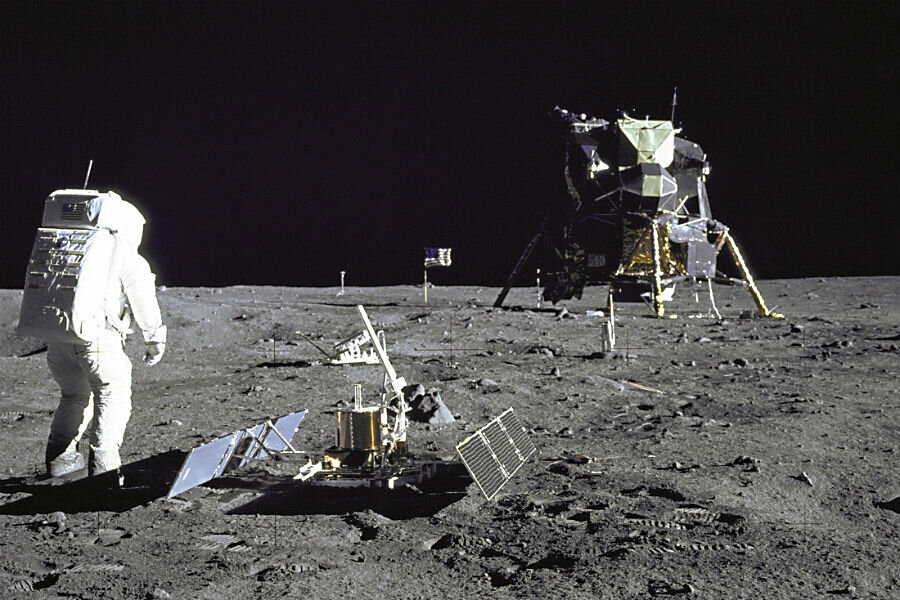Did the moon shift its axis? Mysterious ice deposits reveal clues.
Loading...
For nearly two decades, scientists have known of two regions on the moon – one about 6 degrees off the north pole and the other off the south pole – that appear to harbor ice. Why they are there and not at the frigid poles with the rest of the moon’s ice, nobody knew.
On Wednesday, a team of researchers proposed a theory. According to their calculations, the moon must have shifted on its axis by nearly 6 degrees over the course of a billion years, displacing the icy regions off the poles. This is supported by the fact that the northern and southern regions of ice are directly opposite each other, say scientists.
“So that a line drawn from one end to the other would pass through the center of the moon,” said researchers from the Planetary Science Institute, University of Arizona, and other institutions around the globe, in an announcement of the research published Wednesday in the journal Nature.
This type of shift is known is a true polar wander, a phenomenon caused when centripetal forces on a rotating body, such as a planet, shift the whole outer surface to move mass toward the center, or the equator, to conserve angular momentum.
“If a huge pile of lead weights suddenly appeared in New York, the city’s latitude would eventually shift to a position slightly southward because of planetary reorientation,” explained Ian Garrick-Bethell, an assistant professor of planetary sciences at the University of California in Santa Cruz who reviewed the Nature paper for publication.
The paper's authors also can explain what caused the planet to rotate. A volcanic region that was active for billions of years during the moon’s early history, called Procellarum, changed the density distribution of the moon, thereby reorienting it when it was still a young planet.
If this theory is right, it means that water could have been on the moon since early in its 4.5-billion-year history, a contradiction to what scientists currently believe: that water was delivered more recently by asteroid impacts.
“It’s not from a comet one billion years ago; it’s been on the moon for longer than that,” Matthew Siegler, a scientist at the Planetary Science Institute in Tucson, Ariz., told the Monitor in an interview.
Scientists have suspected since the 1960s that there is water on the moon. They expected that it froze in the moon’s permanently dark and cold polar craters.
But in 1998, scientists at the Los Alamos National Laboratory in New Mexico used data collected by a NASA moon orbiter to find what appeared to be ice slightly displaced from each of the moon’s poles – the same regions that Dr. Siegler and his team have now tried to explain – by pinpointing hydrogen deposits there.
Los Alamos scientists were able to identify the hydrogen, a chemical component of water, by observing the behavior of lunar neutrons near the moon’s surface.
When high-energy protons from radiation in the solar system smack into lunar soil, they shatter atoms there, flinging neutrons into the upper layers of soil. The neutrons leak out of the soil, though much more slowly and less energetically when they they hit hydrogen atoms. By observing the slower neutrons, scientists are able to find hydrogen. Though whether the hydrogen comes from water is not guaranteed.
“That is one of the remaining questions,” Prof. Garrick-Bethell told the Monitor in an interview.
Another puzzling question the theory raises, says Garrick-Bethell, is why the deposits are only about 6 degrees from the current poles. If the poles kept moving over many years, the ice would have kept forming at the poles and moving with the rotating planet, forming a path of ice.
How any of the ice could have survived, given that the soil on the moon churns when an asteroid hits it and then gets heated by the sun, also remains a mystery.
“You would have thought that ice would have been churned up and heated and disappeared over millions of years, but it hasn’t,” he says.
“It's an interesting puzzle that needs to be solved,” says Garrick-Bethell.








